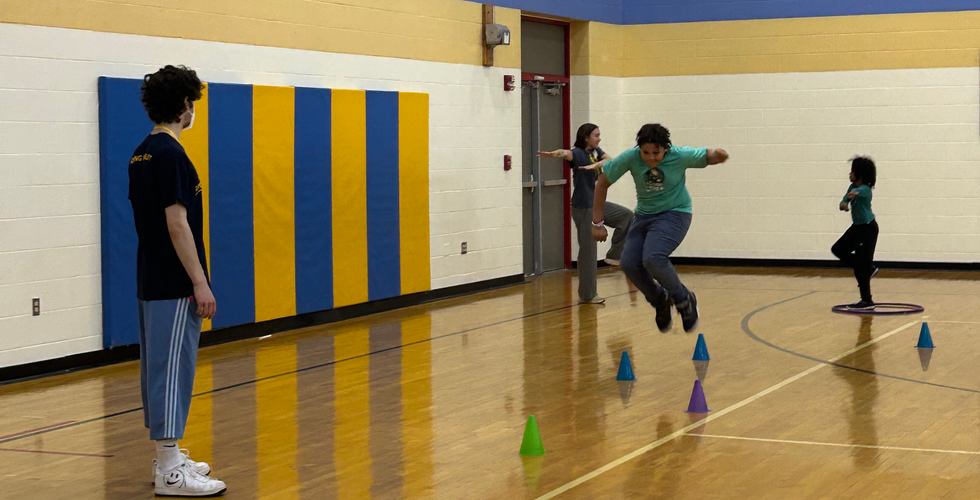Kinection for Learning residency program puts into motion concepts from Willson Elementary students’ academic studies
- Steve Sucato
- Jun 18, 2024
- 3 min read
By Steve Sucato
GroundWorks DanceTheater returned to Willson Elementary this past February-May for its latest Kinection for Learning residency program with the students. The program, designed to support and enhance classroom learning through creative movement and kinesthetic learning, engaged with Willson’s 3rd and 4th-grade students this time.
Funded by an Ohio Arts Council Arts partnership grant, the 50-minute classes took place in the school’s gymnasium on Thursday mornings for the 4th graders and Friday mornings for the 3rd-grade students.
The residency was led by GroundWorks Director of Education & Community Engagement Joan Meggitt and Lead Teaching Artist Morgan Ashley, with GroundWorks’ company teaching artists Ahna Bonnette, Emma Janus, Teagan Reed, Victoria Rumzis, and Matthew Saggiomo filling out the teaching staff. Also on hand were some of Willson’s faculty to support the residency, whether as observers, facilitators, or, in the case of physical education teacher Christopher Campbell, preparing the students for the classes with calisthenics and running exercises.
The Kinection for Learning residency program focused on supporting Willson’s English and Science curriculum, says Ashley and began with teaching the students about movement qualities. “We asked the students questions such as, ‘Can you move like a hot air balloon?’ This would then be translated to high, light, and floaty movements.”
Other movement qualities the 3rd-grade students worked on included swinging, vibratory, and collapsed concepts. The 4th-graders' lessons centered on what it meant to be suspended or percussive.
Ashley, who took charge of the 3rd-grade students, says another section of the residency paired with the students' academic studies of the water cycle and concepts such as evaporation, condensation, and the different states of matter.“ I had the students find qualities for them to move like liquid water, freezing and frozen water, and like steam,” says Ashley. Those qualities were also explored in small groups led by one of GroundWorks’ company teaching artists, who each focused on a particular aspect of the water cycle and were tasked to develop a movement phrase to illustrate that portion of the water cycle.
Ashley also developed lessons around the students' reading of J. M. Barrie’s novel Peter Pan and Wendy, which touched on the concept of “Neverland,” both from the book’s interpretation and each student’s individual idea of “Neverland.”
Meggitt planned the residency curriculum for the 4th-graders, which tied in with the students' academic lessons on freeform poetry and self-expression. She created a worksheet that had the students describe themselves in three ways. Then, the students created movement qualities to match some of those descriptions. One example was a student who said they liked sports, and they illustrated that through movement, mimicking the throwing of a football.
With each movement exercise the students did, the goal was to reinforce with their bodies and physicality what their minds were learning in their academic classes.
Each grade level had culminating showings of what they learned on their second to last day of the residency.
On the final day, the 3rd—and 4th-grade students participated in obstacle courses designed by Ashley and Meggitt, which added another layer to the students' engagement and learning during the residency.
Ashley’s obstacle course featured specific prompts and exercises at stations around the course that revisited the water cycle and Peter Pan lessons, as well as word card movement quality descriptors. Along the way, the students navigated cones and passed through hoops to reach the course's end. Meggitt’s obstacle course for the 4th-graders had them weaving through cones, hula hooping, balance challenges, using word cards, and locomotor prompts to make shapes and move a certain way to the next station and ended with a dance-off.
For Ashley, Meggitt, and the rest of GroundWorks’ teaching staff, working with Willson’s 3rd and 4th graders was both rewarding and occasionally obstacle-filled. Says Ashley, “Over the course of the residency, we got to know the students and built a relationship with them where we found ways to get them really engaged, excited, and participating in the classes.”








